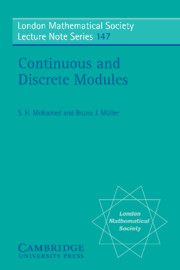Chapter 5 - Discrete Modules
Published online by Cambridge University Press: 06 January 2010
Summary
The short first section investigates when a quasi–discrete module is discrete or quasi–projective. The next section studies the endomorphism ring of a (quasi–)discrete module, and contains results analogous to those in Section 1 of Chapter 3. The final section provides an explicit description of all discrete modules over commutative noetherian rings.
DISCRETE MODULES
The first lemma, and its proof, are dual to Lemma 3.14.
Lemma 5.1. A quasi–discrete module M is discrete, if and only if every epimorphism M →> M with small kernel is an isomorphism.
PROOF. The necessity of the condition is obvious. Conversely, to establish (D2), let f : M →> N be an epimorphism, with kernel K, onto the summand N of M. As M is quasi–discrete, there is a decomposition M = A ⊕ B with A ≤ K and B ∩ K << B. Now N ≅ M/K = K+B/K ≅ B/B ∩ K. Theorem 4.24 yields N ≅ B. Let g : N > < B be an isomorphism. Then M = A ⊕ B A ⊕ N A ⊕ B = M is an epimorphism with the small kernel B ∩ K. By assumption, it is an isomorphism, that is B ∩ K = 0. Then K = A ⊕ B ∩ K = A C⊕ M, and f splits.
The following theorem allows to determine when a quasi–discrete module is discrete or quasi–projective. Recall that a quasi–discrete quasi–projective module is always discrete (Proposition 4.39).
Theorem 5.2. Let M = Mibe a quasi–discrete module, represented as a direct sum of hollow submodules, according to Theorem 4.15.
- Type
- Chapter
- Information
- Continuous and Discrete Modules , pp. 81 - 94Publisher: Cambridge University PressPrint publication year: 1990



